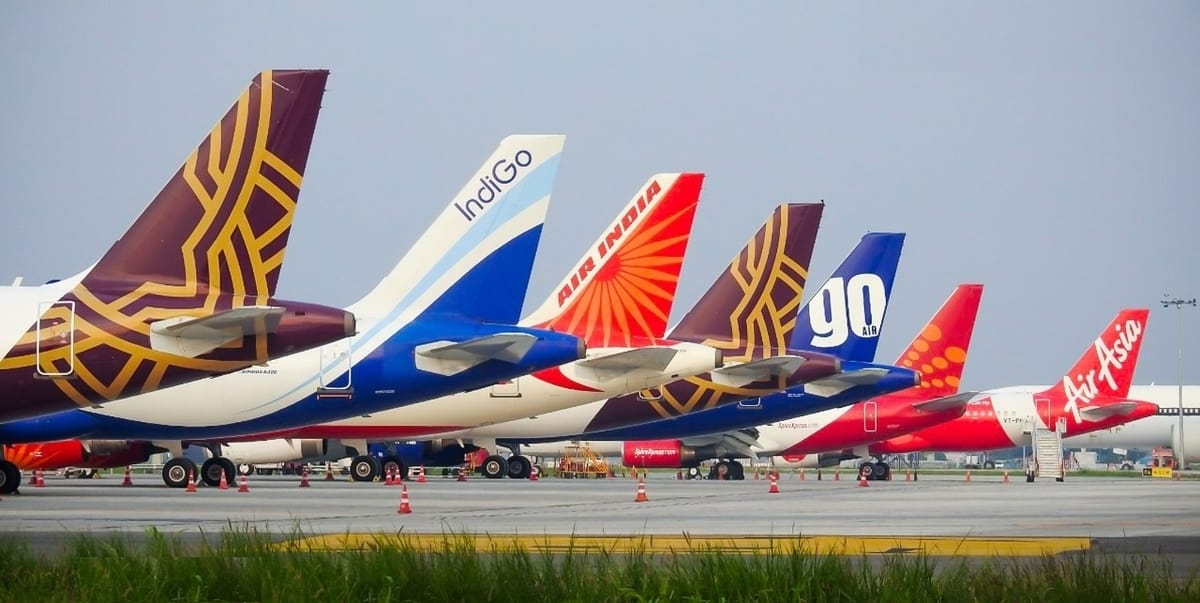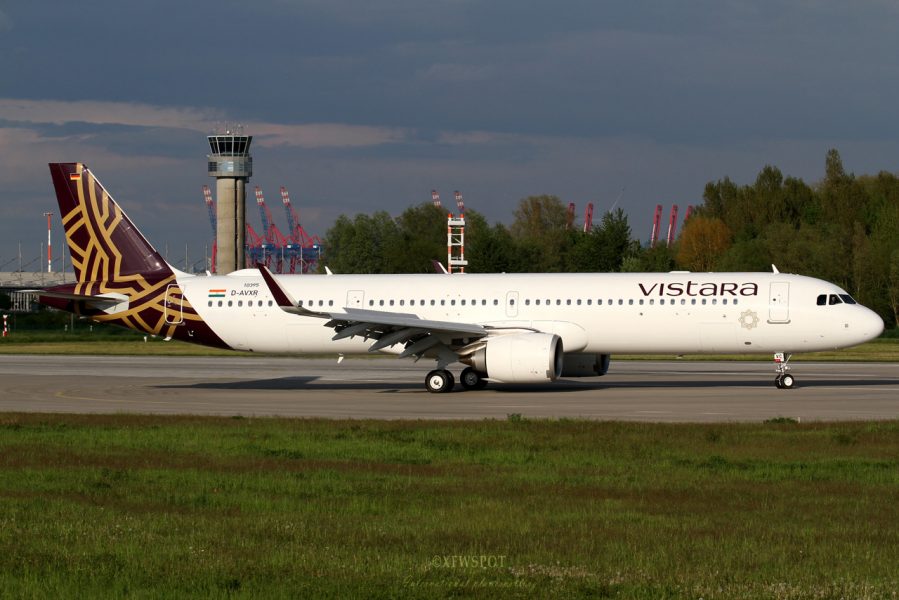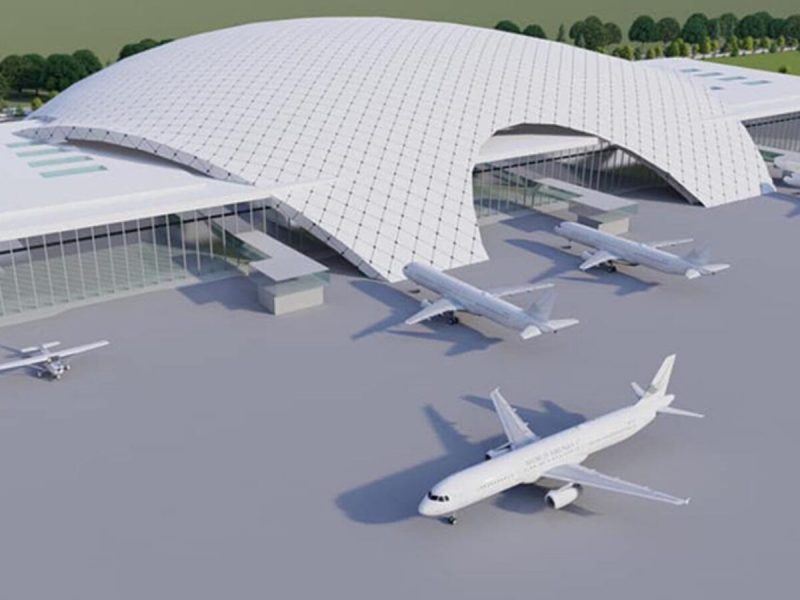Vistara is upgrading its fleet of Airbus A321LR aircraft with a satellite-based cockpit connectivity system from Cobham Aerospace.
In emailed statements to Avionics International, representatives for Cobham Aerospace explained that their AVIATOR 200S SwiftBroadband system is being added to four A321LR aircraft operated by the joint venture of Tata Group and Singapore Airlines.
Cobham AVIATOR 200S
Vistara's selection of the AVIATOR 200S includes the addition of a Compact Satellite Data Unit (CSDU), Enhanced LGA Antenna with built-in HPA and DLNA (HELGA), and SATCOM Configuration Module (SCM) to their A321LR.
“We are pleased that a prominent international carrier such as Vistara has placed their trust in AVIATOR S. We have every confidence that AVIATOR will exceed performance expectations, leading to even greater market acceptance of this groundbreaking SATCOM system."Eiji Kawaishi, CEO, Cobham Aerospace Communications
Compared to previous generations of aircraft satellite communication systems, "200S offers two segregated aircraft communication domains, an 80-times increase in data-transfer capacity, as well as safety services-approved ACARS and SATVOICE," the company said in a press statement announcing the Vistara selection.
Airbus A321neo
Cobham Aerospace's AVIATOR 200s is has achieved type certification for the Airbus A320 Family, A330, and A350 platforms.
According to Cobham, the AVIATOR 200S combines the provision of SwiftBroadband Aircraft Communications Addressing and Reporting System (ACARS) data services with an Internet Protocol (IP) data pipe for the transfer of operational and flight data to ground maintenance and control facilities, or real-time weather and other flight relevant information updates to Electronic Flight Bags (EFBs) or Flight Management Systems (FMS).
Vistara Airbus A321neo
Other features of the system include a Compact Satellite Data Unit (C-SDU) which is deployed with a phased array antenna with built-in Diplexer, Low Noise Amplifier (DLNA), and High Power Amplifier (HPA).
AVIATOR 200S offers interfaces capable of supporting future 4D trajectory-based Operations routing systems for continental (SESAR and NextGen) and oceanic use, according to Cobham.
The cockpit of Airbus A321neo (Image Courtesy - Wikimedia Commons)
"4D Trajectory Guidance is a primary application of interest where Cobham sees significant opportunity for growth in [Air Traffic Control] ATC efficiencies. It will replace and improve legacy cockpit Safety Services offered by legacy network technology for Safety Voice and CPDLC data for ATC communications. Further applications would include data connectivity driven apps offered on Airbus’ FOMAX Platform," the representative for Cobham said.
The AVIATOR 200S selection for Vistara comes as the airline continues to report ongoing fleet and flight operational expansion. Vinod Kannan took over as CEO of Vistara in January for Leslie Thng, who is taking on a senior role with Singapore Airlines after four years as the CEO of Vistara.
(With Inputs from Aviation Today)
Read next
INR 10,667 crore allocated for the Civil Aviation Ministry in the Union Budget 2022
Radhika Bansal
02 Feb 2022

The Union Budget has allocated INR 10,667 crore for the civil aviation ministry for 2022-23, according to the document presented by Finance Minister Nirmala Sitharaman on Tuesday, February 1.
Out of the total allocation, INR 600.7 crore has been earmarked for the regional connectivity scheme UDAN (Ude Desh ka Aam Naagrik), while INR 9,259 crore goes to AI Asset Holdings Limited for servicing the loans transferred to the special purpose vehicle (SPV) for the financial restructuring of Air India.
An amount of INR 165 crore has also been set aside for the medical benefits of retired Air India employees, the Budget document said.
Finance Minister Nirmala Sitharaman with the Union Budget 2022.
Air India was taken over by Tata Group firm Talace on January 27. Through a competitive bidding process, the government sold loss-making Air India to Talace for INR 18,000 crore. As part of the deal, Talace paid INR 2,700 crore in cash and took over the INR 15,300 crore debt of the airline. The remaining debt and borrowings of Air India were transferred to AIAHL.
As of August 31, 2021, Air India had a total debt of INR 61,562 crore. The airline also had about INR 15,000 crore excess liabilities towards unpaid fuel bills and other operational creditors.
According to the budget document, the government infused INR 36,254 crore in AIAHL during 2021-22 "for repayment of past government-guaranteed borrowings of Air India Limited".
Air India was taken over by Tata Group firm Talace on January 27.
Further, the government put in INR 12,357 crore equity in AIAHL in 2021-22 "for repayment of past government-guaranteed borrowings (lease rental for aircraft) of Air India Limited", as per the document.
Last fiscal, it also infused Rs 13,446 crore equity in AIAHL for repayment of past dues/ liabilities of Air India. The total equity infusion in AIAHL was Rs 62,057 crore in 2021-22.
In 2021-22, the civil aviation ministry was allocated INR 3,224 crore, however, the government incurred high expenses during the divestment of Air India and, as a result, the revised expense for the civil aviation ministry during 2021-22 stood at INR 72,652 crore.
Out of the total revised figure for 2021-22, the allocation towards Air India loans, grants in aid to Air India for cash losses during the COVID period and towards Air India Assets Holding Company for re-payment of dues and borrowings of the airline stood at INR 68,501 crore.
In 2021-22, the civil aviation ministry was allocated INR 3,224 crore.
In the Budget for 2021-22, the government had allocated INR 600 crore for the UDAN scheme, but the total expenditure rose to INR 994 crore.
While the finance minister did mention that airports would power the economic growth as a part of the PM Gati Shakti programme, she did not share any details on how this would be achieved.
The government also did not come out with any measures such as a cut in the excise duty charged on aviation turbine fuel, to help airlines grappling with high operating costs.
ALSO READ - IndiGo expected a reduction in excise duty on jet fuel in Union Budget 2022
Budget carrier IndiGo termed the Union Budget 2022-23 as “growth-oriented” while expecting a cut in the excise duty on jet fuel. Ronojoy Dutta, Whole-Time Director and CEO, IndiGo said that they were expecting tax concessions to the aviation industry in the form of a cut in ATF (Aviation Turbine Fuel) excise duty and the allocation of concessional finance to airlines to help us come out of the pandemic.
ALSO READ - Aviation Turbine Fuel prices rise by a whopping 8.5% to new highs
To make things trickier, the Indian government announced a price hike on ATF by up to 8.5%, just ahead of the budget. ATF price has gone up to INR 86,038.16 per kiloliter (kl) in the national capital region, the highest ever. Price hikes like these are usually passed down to passengers, reflecting on their ticket prices.
https://imasdk.googleapis.com/js/core/bridge3.496.0_en.html#goog_1210032461Click To UnMuteWhile most airlines and airport operators in India have hailed the government's call to develop infrastructure and increased capital expenditure allocation, most of them were also disappointed with no support from the government for the sector.“We were expecting tax concession for the aviation industry in the forms of a cut in ATF excise duty and allocation of concessional finance to airlines to help us come out of the pandemic,” IndiGo CEO Ronojoy Dutta said in a statement after Sitharaman's Budget speech.
Read next
Next Generation cargo drone with innovative blended wings to propel Air Cargo Industry to new heights
Prashant-prabhakar
02 Feb 2022

While it is known that air freight is faster and safer than transporting via water, it is never cheap and often comes at a hefty price. Ocean freight, on the other hand, is a more affordable option while offering more capacity at the same time. Consequently, it always boils down to calculation and cost comparison before choosing the right mode of shipment.
Natilus, a Californian startup, is reinventing the 75-year-old status quo of freight transportation through innovation and advanced technologies, to make air freight costs competitive to cargo shipping and dramatically improve delivery times.
The company has designed and developed a blended-wing, autonomous global air freight system touted to pack in 60% more cargo than an aircraft of the same size.
sUAS News
Tech and spec(s)
The model, dubbed as "The Natilus N3.8T", has a range of 1,667 km (1,035 miles) and will be capable of carrying loads of up to 3,855 kg (8,500 lb) and have enough space for far more cargo inside than a traditional aircraft of the same weight.
Representative | Natilus
The use of standardized containers (LD3) is one of the UAV’s features, along with a blended wing-body design and remote piloting.
It will be the first model to roll off the rank for Natilus and will have an MTOW of 8,618 kg (19,000 lb).
Maximum Efficiency : With an enhanced aerodynamic profile, the design would operate with 50% less CO2.
60% more cargo : With a design centred around cargo, the patent-pending ‘Diamond’ cargo-bay offers an efficient blended wing body configuration that allows for 60% more volume. Additionally, the aircraft can hold a large configuration of standard pallets, outsized cargo, and without a contouring requirement-all with a remote pilot watching over.
Natilus
'Fly-by-Mouse' Autopilot : Natilus FAA certifiable autopilot allows air freight operators to scale with Natilus products, thereby also addressing pilot shortages in the aviation industry.
Natilus
From a freight perspective, it makes a lot sense. It has 50 percent more volume internally, so it doubles the amount of revenue cargo per flight. With conventional designs you start to run out volume before you maximize the takeoff weight of the airplane.Aleksey Matyushev, CEO and Co-Founder, Natilus
Natilus is using Siemens NX™products to support product development from concept through manufacturing and certification. Using NX™ products allows Natilus engineers to reduce its development times for the groundbreaking Blended Wing Body (BWB) prototype by half.
Volatus Aerospace, whose activities range from UAV sales, pilot training, specialized public safety services, drone delivery, and other enterprise operations, has secured delivery of next-generation Natilus long-distance cargo drones, with the first production run of the craft expected in 2025.
SOURCE(s)
COVER: New Atlas
Read next
IndiGo expected a reduction in excise duty on jet fuel in Union Budget 2022
Radhika Bansal
02 Feb 2022
Budget carrier IndiGo termed the Union Budget 2022-23 as "growth-oriented" while expecting a cut in the excise duty on jet fuel.
"Budget 2022-23 appears to be growth-oriented by an increase in the capital outlay of INR 7.5 lakh crore, fiscal deficit capped at 6.4% and efforts are being made to reduce compliance burdens and improve ease of doing business.We expect the Budget would enable India to achieve a growth estimate of 9.2%.Having said that, we were expecting tax concessions to the aviation industry in the forms of cut in ATF (aviation turbine fuel) excise duty and the allocation of concessional finance to airlines to help us come out of the pandemic."Ronojoy Dutta, Whole-Time Director and CEO, IndiGo
Welcoming the new incentives of issuing e-passports and the introduction of digital currency, Dutta said the government’s "relentless" focus on the national transportation infrastructure development with the PM Gati Shakti National Master Plan will strengthen the much-needed multimodal connectivity.
Also, besides facilitating the seamless movement of cargo, the plan will reduce logistics costs as well, he added.
IndiGo expected a reduction in excise duty on jet fuel in Union Budget 2022
Earlier, Finance Minister Nirmala Sitharaman in her Budget Speech on Tuesday, February 1 said the PM Gati Shakti National Master Plan is a transformative approach for economic growth and sustainable development and is driven by seven engines including roads, railways, airports, ports, mass transport, waterways and logistics infrastructure.
All seven engines will pull forward the economy in unison, Sitharaman said while presenting the Budget for 2022-23. These engines are supported by the complementary roles of energy transmission, information technology communication, bulk water and sewerage and social infrastructure.
Read next
IAF receives 3 Rafale fighter jets with India-specific upgrades from France
Radhika Bansal
02 Feb 2022
The Indian Air Force (IAF) on Tuesday, February 1 received three of the last four Rafale fighter jets. The fighter planes were handed over by France at the Istres-Le Tube airbase of Rafale manufacturer Dassault Aviation which is situated northwest of Marseille.
After this, the IAF will wait for the right opportunity to take the fighter jets to India between February 15 and 20. According to people aware of the developments, the handed over planes will now be test-checked for all the details. The fighter jets are expected to arrive in India between February 15 and 16, the people cited above said.
IAF will wait for the right opportunity to take the fighter jets to India between February 15 and 20.
According to a report by The Hindustan Times when the Rafale jets will fly out of France, these fighter jets will receive mid-air refuelling by the air force of India’s close ally, the United Arab Emirates, using Airbus multi-role transport tankers.
These Rafale fighter jets are fully equipped with India specific enhancements, which will give them extra teeth to fight any regional adversary.
The last fighter jet is nearly ready with fresh paint and enhancements but will arrive in April due to the reasons best known to IAF.
Rafale jets will get mid-air refuelling by UAE Air Force.
The last of the 36 contracted fighters from France is actually the first fighter used for training IAF personnel after the deliveries started from France. This fighter was inspected by Defence Secretary Ajay Kumar at the Istres airbase during his visit to France for a high-level defence dialogue in December 2021.
Although IAF remains tight-lipped over what India specific enhancements are on Rafale, it is learnt that these relate to long-range Meteor air-to-air missile, low band frequency jammers, advanced communication systems, more capable radio altimeter, radar warning receiver, high altitude engine start-up, synthetic aperture radar, ground moving target indicator and tracking, missile approach warning systems and very high-frequency range decoys.
IAF receives 3 Rafale fighter jets with India-specific upgrades from France
On the arrival of the fighter jets, the IAF will test the specific enhancements to their satisfaction under Indian conditions apart from verifying the original equipment manufacturers claims as per agreement.
After this, work will begin in retrofitting the remaining 32 aircraft at Ambala in the western sector and Hashimara airbase in the eastern sector with the India specific enhancements with all the related equipment already with the IAF. The upgradation exercise will be carried out at Ambala airbase which has the maintenance cum repair set up for Rafale fighters in India.
(With Inputs from The Hindustan Times)
Read next
Nepal's second international airport will start its operation in May 2022, Minister for Tourism and Civil Aviation said.
All international flights can take off and land at the Gautam Buddha International Airport (GBIA) from May 26, the birth anniversary of Lord Buddha, Nepal's Minister for Tourism and Civil Aviation Prem Ale informed while inspecting the airport under construction in Bhairahawa, situated in Western Nepal.
If there is any technical problem in the plane flying in the Nepali sky, the situation of diverting the aeroplane to Kathmandu for emergency landing will come to an end. At present, there is no alternative to returning to the Tribhuvan International Airport (TIA) for an emergency landing.
For emergency landings, the planes will not have to be either diverted to India or head to the Kathmandu airport once GBIA comes into operation. Currently, only TIA has emergency landing facilities with 'foam and fire' vehicles. Arrangements have been made at GBIA for its operation.
The GBIA, which is being prepared for operation, also has minimum standards required for an emergency landing as per the International Civil Aviation Organisation (ICAO) standards. Aircraft that could not land in Kathmandu due to problems and adverse weather will now be able to land safely in Bhairahawa.
An expert team of Aeronautical Radio of Thailand (AeroThai) has already arrived in Nepal to prepare for a mechanical test flight (calibration flight) to verify whether the new airport is technically sound or not.
The construction work of the physical infrastructure of the airport has been completed by the Chinese company Northwest Civil Aviation Construction Group.
Tribhuvan International Airport
A team of AeroThai experts will fly the calibration flight to find out if the flight equipment is working. According to airport officials, the calibration and test flight will be carried out within a month.
''A team of AeroThai experts is working to bring the airport into operation on the occasion of Buddha Jayanti,'' the officials informed.




Comment